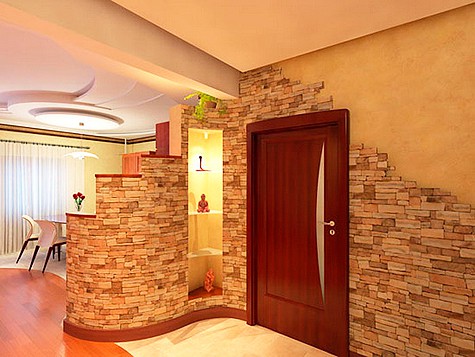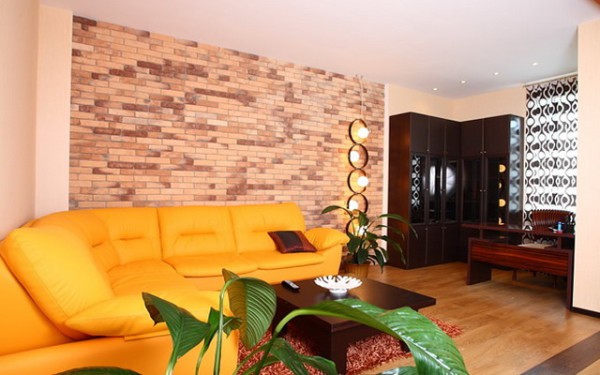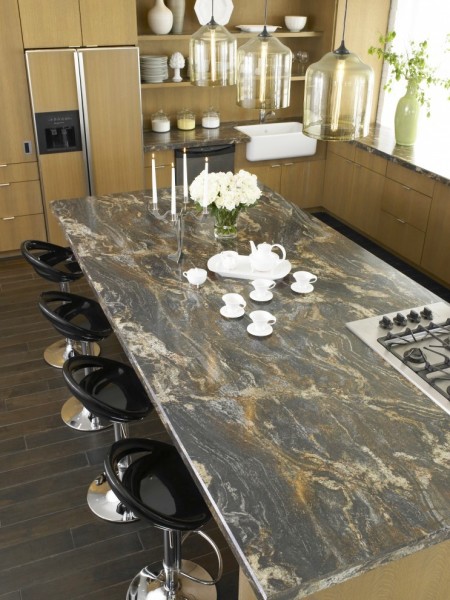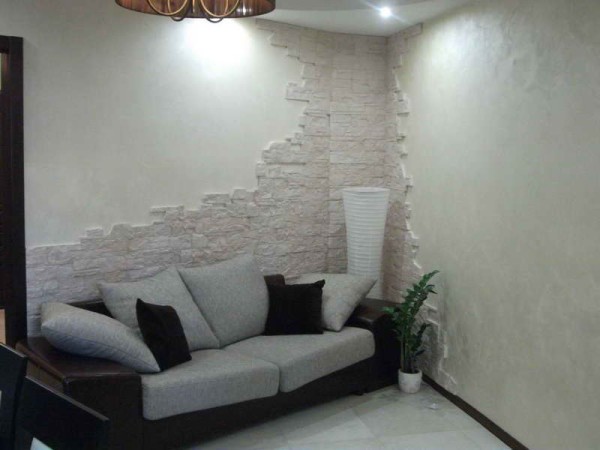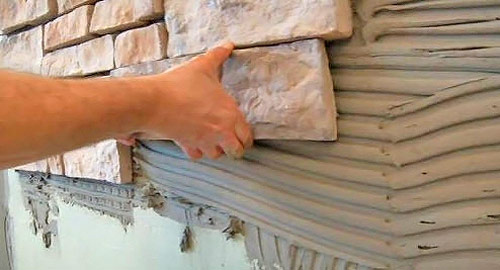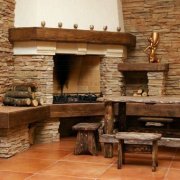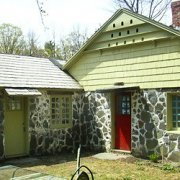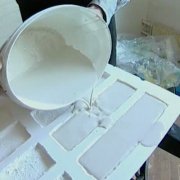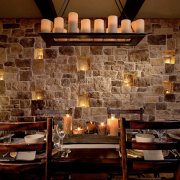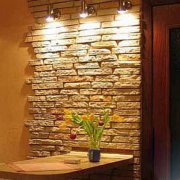Decorative stone for interior decoration
Finishing work both outside and indoors should be carried out efficiently. To do this, at the moment there is a huge selection of modern finishing materials.
The most popular and sought-after design today is the interior decoration with decorative stone.
The content of the article
Types of Artificial Stone
Stone finish Indoors has become in great demand.
For such works, different types of decorative stone are used:
- Based on concrete.
- Porcelain tile.
- Conglomerates.
- Acrylic.
- Quartz.
- Gypsum.
According to their technical characteristics, not all of these types have differences, but the methods for their manufacture are different. In the photo there are examples of such artificial stones that are quite common in decorating.
Concrete-based decorative stone
This kind artificial stone It consists of sand, cement, coloring pigments, reinforcing additives, plasticizers and a variety of fillers. As a rule, ceramic chips, pumice, expanded clay are used in their quality.
Note. You can use such a stone on any surface and this type of material is considered the most common.
Porcelain Tiles
This decorative stone for interior decoration is more durable.
It consists of:
- Clays
- Feldspar.
- Minerals.
- Coloring pigments.
Material Features:
- For its manufacture, several types of clay are used to improve the strength of the finishing material. The mixture, which consists of these ingredients, is pressed, after which the resulting material is fired.
- This is not to say that granite is very similar to stone. It most likely resembles a glass tile of a certain color.
It is very durable and reliable, able to withstand significant temperature changes, does not absorb moisture.
Tip.
It is impossible to clean the surface of such a decorative stone with abrasive cleaning agents, since they can interfere with the appearance of the finish. It is also not recommended to use porcelain stoneware in the design of a kitchen apron, since it will be quite problematic to clean grease stains from the surface.
Conglomerates
This is the most durable and most reliable stone for interior decoration. It consists of crushed granite and marble.
To them is added quartz sand, crushed limestone and a variety of coloring substances.
Features:
- In appearance, this material very much resembles a natural agglomerate.
- He is very hardy and able to withstand various temperature changes.
- Frost-resistant, and does not fade in the sun.
- It is also worth considering that the weight of such a stone is quite small, which makes it possible to carry out installation independently.
Note.
Its surface is very much like marble or granite, slate and no specialist can not distinguish it from natural stone. This material is used to make worktops or wall surfaces.
Acrylic decorative stone
Very practical is the acrylic facing stone for interior decoration.
Differences:
- It has excellent technical properties and characteristics.
- It does not absorb moisture and is not able to deform under mechanical and physical influences.
- Contamination does not accumulate on its surface and it can be cleaned with a simple damp rag without the use of any detergents.
- Acrylic stone is lightweight and easy to process.
- It is safe for human health, which makes it possible to use it even when decorating children's rooms.
The stone has a variety of colors and sizes. It does not burn and can withstand significant temperature changes.
Quartz decorative stone
This type of artificial stone is a strong and durable finishing material. It is used in any room and at any temperature.
The stone is frost-resistant and does not fade in the sun. It is able to withstand quite large loads and not be deformed.
Quartz stone is very easy to use and process. It is cut with diamond discs.
Tip. In the process of cutting, it is necessary to protect the respiratory tract from the ingress of stone dust. It is necessary to constantly spray the stone with water.
Gypsum decorative stone
Plaster decorative facing stone used for interior decoration for many years. It has a very attractive appearance and low weight.
Features:
- This is not to say that it is completely moisture resistant. Its surface does not absorb moisture only if it is reliably protected by a coating.
- It does not burn, does not deform under the influence of high and low temperatures.
- Its installation is quite simple.
- In appearance, it resembles sandstone, since in most cases it has the same coloring.
- The main advantage of such a stone will be that you can make it yourself.
There is a special instruction, according to which the whole process is carried out.
For this you need:
- Plaster dough.
- Special forms.
- Lubricant
- Coloring pigments.
Stages of manufacturing:
- Initially, gypsum dough is prepared and dyes of the desired shade are added to it.
- After that, all forms are smeared and this solution is poured into them. The dough should freeze in molds.
- Then it is knocked out with a rubber mallet, turning the mold over.
- The finished material must lie down for at least 24 hours to get stronger.
Only after that it can be mounted on the wall.
The advantages of decorative stones and the range of their application
The main advantage of any decorative stone there will be its price, which is several times lower than the cost of natural stone.
These materials are strong and durable. The average term of their operation is at least 10-15 years.
They are easy to install and process.
Note.
Most species are not able to absorb moisture and various contaminants. Decorative stone can withstand quite large temperature differences and at the same time not be deformed.
They also withstand significant loads, despite their low weight.
Range of application:
- Decorative stone can be found on any inner surface. It is very often used for decorating on arches (seeDecorating an arch with decorative stone - basic rules and requirements) or other decorative elements.
- As a rule, in this case, fragmentary stone technology is used for interior decoration. These are stones that are mounted on a surface that do not have a clearly defined shape on it.
Some may appear on several stones and so on. - Sometimes the lower part of the wall or fireplace is decorated with artificial stone. The decoration of the internal corners with a decorative stone looks original.
Combine such a finishing material with decorative plaster.
Tip.It is not recommended to use decorative stone in the kitchen area, since cleaning the surface of this material is impossible without the use of abrasive products that can damage the finish surface.
Mounting decorative stone
The installation process of decorative stone is quite simple. It is carried out on a previously prepared surface.
For mounting on the surface of the stone you will need:
- Special glue or cement mortar.
- Level.
- Two spatulas.
Tip. Initially, it is worth considering the design of the surface and apply points on it with a pencil on which the installation will be carried out.
After that, glue or cement mortar is applied to the surface, for the preparation of which it is necessary to use:
- Cement grade 400.
- Water.
- Sand.
Tip. As a rule, the proportions for mixing the mortar are standard - 1 bucket of cement to 3 buckets of sand.
To increase strength, less sand can be used. The mixture is mixed using a construction mixer, which will save time and effort.
So:
- The resulting or finished solution is applied to the surface in a small layer. It is necessary to let it grow stronger for a few seconds and only after that carry out the fixing of the stone.
A solution is also applied to its inside, only in a small amount so that there are no protrusions on the surface. If they are, then they are removed with a spatula. - The principle of laying decorative stone is similar to laying ceramic tiles. Only in this process you can not use the cross-shaped lighthouses.
The stone lies close to each other. Again, it all depends on the installation method chosen and the desired finish.
Tip. Most stones have a matte surface and quite often it is varnished to give a shine to the finish and increase the life of the decorative stone.
After the installation of the stone is completely finished, you can use a decorative putty of the necessary shade to mask the seams or chips that could be during operation. The video shows the installation of decorative stone.
Preparatory work on the surface for the installation of decorative stone
Decorative cladding stone for interior decoration can only be mounted on a flat surface. Not only the appearance of the finish depends on this, but also its strength.
For such works, drywall or plaster is used. Drywall is mounted on a metal frame from profiles (lathing).
Then its joints are glued with construction tape and putty. On such a surface it is already possible to mount decorative stone.
The use of plaster is characterized by the duration of the process. Initially, starting plaster layers are applied to the surface, each of which is treated with sandpaper.
Then the finishing plaster, which is also treated with sandpaper, is only smaller. The process is dusty and after it is necessary to clean the premises with high quality.
